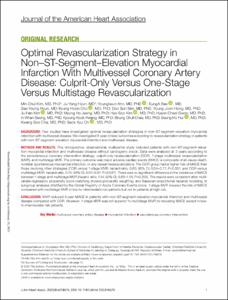KUMEL Repository
1. Journal Papers (연구논문)
1. School of Medicine (의과대학)
Dept. of Internal Medicine (내과학)
Optimal Revascularization Strategy in Non-ST-Segment-Elevation Myocardial Infarction With Multivessel Coronary Artery Disease: Culprit-Only Versus One-Stage Versus Multistage Revascularization
- Affiliated Author(s)
- 허승호
- Alternative Author(s)
- Hur, Seung Ho
- Journal Title
- Journal of the American Heart Association
- ISSN
- 2047-9980
- Issued Date
- 2020
- Abstract
- Background:
Few studies have investigated optimal revascularization strategies in non–ST‐segment–elevation myocardial infarction with multivessel disease. We investigated 3‐year clinical outcomes according to revascularization strategy in patients with non–ST‐segment–elevation myocardial infarction and multivessel disease.
Methods and Results:
This retrospective, observational, multicenter study included patients with non–ST‐segment–elevation myocardial infarction and multivessel disease without cardiogenic shock. Data were analyzed at 3 years according to the percutaneous coronary intervention strategy: culprit‐only revascularization (COR), 1‐stage multivessel revascularization (MVR), and multistage MVR. The primary outcome was major adverse cardiac events (MACE: a composite of all‐cause death, nonfatal spontaneous myocardial infarction, or any repeat revascularization). The COR group had a higher risk of MACE than those involving other strategies (COR versus 1‐stage MVR; hazard ratio, 0.65; 95% CI, 0.54–0.77; P<0.001; and COR versus multistage MVR; hazard ratio, 0.74; 95% CI, 0.57–0.97; P=0.027). There was no significant difference in the incidence of MACE between 1‐stage and multistage MVR (hazard ratio, 1.14; 95% CI, 0.86–1.51; P=0.355). The results were consistent after multivariate regression, propensity score matching, inverse probability weighting, and Bayesian proportional hazards modeling. In subgroup analyses stratified by the Global Registry of Acute Coronary Events score, 1‐stage MVR lowered the risk of MACE compared with multistage MVR in low‐to‐intermediate risk patients but not in patients at high risk.
Conclusions:
MVR reduced 3‐year MACE in patients with non–ST‐segment–elevation myocardial infarction and multivessel disease compared with COR. However, 1‐stage MVR was not superior to multistage MVR for reducing MACE except in low‐to‐intermediate risk patients.
- Department
- Dept. of Internal Medicine (내과학)
- Publisher
- School of Medicine (의과대학)
- Citation
- Min Chul Kim et al. (2020). Optimal Revascularization Strategy in Non-ST-Segment-Elevation Myocardial Infarction With Multivessel Coronary Artery Disease: Culprit-Only Versus One-Stage Versus Multistage Revascularization. Journal of the American Heart Association, 9(15), e016575. doi: 10.1161/JAHA.120.016575
- Type
- Article
- ISSN
- 2047-9980
- Appears in Collections:
- 1. School of Medicine (의과대학) > Dept. of Internal Medicine (내과학)
- 파일 목록
-
-
Download
 oak-2020-0365.pdf
기타 데이터 / 1.81 MB / Adobe PDF
oak-2020-0365.pdf
기타 데이터 / 1.81 MB / Adobe PDF
-
Items in Repository are protected by copyright, with all rights reserved, unless otherwise indicated.